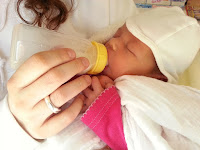It's scary, isn't it?
The idea that babies, in general, are consuming around 1.6m microplastic particles per day is enough to panic most parents, myself included. This number was reported in a story published in the Guardian this morning.
 |
| Image by Dirk (Beeki®) Schumacher from Pixabay |
This number is significantly higher than the World Health Organization's estimate for microplastics in drinking water, a report published last year.
As it happens, the procedures used to ensure sterile bottles and formula blending actually contribute to this microplastic fiasco:
"The team followed international sterilisation guidelines to make baby formula in 10 different feeding bottles. This involves sterilising with 95C (203F) water, then shaking the formula powder with 70C water in the bottle. Both the hot water and shaking steps produced a lot of microplastics, which are far smaller than the width of a human hair." (Damian Carrington, The Guardian)
Yikes!
Fortunately, the scientists involved in the study theorized that adding one simple step to the end of the sterilization procedure brings this amount of microplastics down to a lower level. What's that step, you ask?
Boil some water, let it cool, and then use that water to rinse out the bottle a few more times.
See? This really is a simple step. The water can easily be boiled and cooled while you're doing other things, which adds almost no time to your bottle sterilization process.
If this isn't enough for you, and you feel that even more steps need to be taken, there is always the idea of switching to glass bottles. They're definitely more environmentally friendly, and you don't need to worry about petrochemicals at all.
I'd like to point out, though, that glass is much heavier than plastic, which is really annoying at a 3:00 a.m. feeding. Also, babies like to throw things and bat them around. This means you'd have to be extra careful during feedings to ensure you don't end up cleaning shattered glass from the area.
Everyone wants to protect their baby from microplastics, but before you get a bit too worried about this new study, I want you to understand that this study was not evaluating whether this amount is dangerous for human consumption or not. And they also point out that many of the particles are automatically eliminated into their diapers.
The study does recommend more studies be done on the subject, but the authors want to be sure that nobody panics over this info.
And they're right. Panic does no good...especially when the authors don't know if this amount has any significant effect on human health.
Instead, as parents, we need to focus on what we can do in this moment. Take that one extra step and you protect your baby by reducing the amount of microplastics consumed.
And once you have that done, start pushing for new, eco-friendly options!
*You can read the study abstract for free in Nature Food.




No comments:
Post a Comment